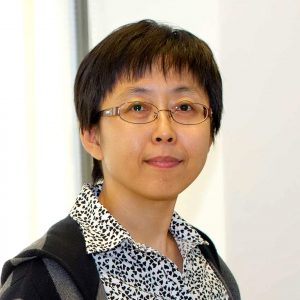
Associate Professor at the School of Biomedical Sciences
Office: (852) 3943 1455
Email: fengbo@cuhk.edu.hk
Address: Room 105A, 1/F, Lo Kwee-Seong Integrated Biomedical Science Building, Area 39, CUHK
SBS Website: https://www2.sbs.cuhk.edu.hk/en-gb/people/academic-staff/prof-feng-bo
Research Profile
Prof. FENG Bo (馮波) is an Associate Professor in the School Biomedical Sciences, Faculty of Medicine, The Chinese University of Hong Kong (CUHK). She is an active staff member in the Developmental and Regenerative Biology Thematic Research Program, Institute for Tissue Engineering and Regenerative Medicine, MOE Key Laboratory for Regenerative Medicine and CUHK-GIBH Joint Laboratory on Stem Cell and Regenerative Medicine. Prof. Feng graduated from Nankai University with B.Sc. (1993) and M.Sc (1996), and received her Ph.D. (2006) from National University of Singapore. After graduation, Prof. Feng joined Prof. Ng Huck Hui’s lab in Genome Institute of Singapore as a postdoc. She worked on stem cells and reprogramming and published her works in Nature Cell Biology, Cell Stem Cell and Nature. In Nov 2010, Prof. Feng joined CUHK and her current research interest lies within the molecular mechanism that controls pluripotency and differentiation of ESCs/iPSCs, as well as development of new tools for gene and cell-based therapy.
Research Interests
- Generation of iPS cells and mechanistic study of reprogramming process
- Molecular mechanisms that control stem cell self-renewal and differentiation
- Stem cell and molecular tools for disease modeling and treatment
- Tissue regeneration
Selected Publications
- He X, Tan C, Wang F, Wang Y, Zhou R, Cui D, You W, Zhao H, Ren J, Feng B#. “Knock-in of large reporter genes in human cells via CRISPR/Cas9-induced homology-dependent and independent DNA repair.” Nucleic Acids Res, 2016; 44(9):e85.
- Wang Y, Qin J, Wang S, Zhang W, Duan J, Zhang J, Wang X, Yan F, Chang M, Liu X, Feng B, Liu J, Pei X. “Conversion of human gastric epithelial cells to multipotent endodermal progenitors using defined small molecules.” Cell Stem Cell, 2016; 19(4):449-461.
- Wang XW, He XJ, Lee KC, Huang C, Hu JB, Zhou R, Xiang XY, Feng B#, Lu ZQ#. “MicroRNA-221 sponge therapy attenuates neointimal hyperplasia and improves blood flows in vein grafts.” Int J Cardiol, 2016; 208:79-86. (#co-correspondence)
- Liu S, Xu Y, Zhou Z, Feng B#, Huang H#. “Progress and challenges in generating functional hematopoietic stem/progenitor cells from human pluripotent stem cells.” Cytotherapy, 2015; 17(4):344-358. (#co-correspondence)
- Tu J, Ng SH, Luk AC, Liao J, Jiang X, Feng B, Lun Mak KK, Rennert OM, Chan WY, Lee TL. “MicroRNA-29b/Tet1 regulatory axis epigenetically modulates mesendoderm differentiation in mouse embryonic stem cells.” Nucleic Acids Res, 2015; 43(16):7805-7822.
- Hu J, Lei Y, Wong WK, Liu S, Lee KC, He X, You W, Zhou R, Guo JT, Chen X, Peng X, Sun H, Huang H, Zhao H, Feng B#. “Direct activation of human and mouse Oct4 genes using engineered TALE and Cas9 transcription factors.” Nucleic Acids Res, 2014; 42(7):4375-4390.
- Ma H, Ng HM, Teh X, Li H, Lee YH, Chong YM, Loh YH, Collins JJ, Feng B, Yang H, Wu Q. “ Zfp322a regulates mouse ES cell pluripotency and enhances reprogramming efficiency.” PLoS Genet, 2014; 10(2): e1004038.
- Ma H, Ow JR, Tan BC, Goh Z, Feng B, Loh YH, Fedele M, Li H, Wu Q. “The dosage of Patz1 modulates reprogramming process.” Sci Rep, 2014; 4:7519.
- Lu X, Goke J, Sachs F, Jacques PE, Liang H, Feng B, Bourque G, Bubulya PA, Ng HH. “SON connects the splicing-regulatory network with pluripotency in human embryonic stem cells.” Nat Cell Biol, 2013; 15(10):1141-1152.
- Do DV, Ueda J, Messerschmidt, DM, Lorthongpanich C, Zhou Y, Feng B, Guo G, Lin PJ, Hossain MZ, Zhang W, Moh A, Wu Q, Robson P, Ng HH, Poellinger L, Knowles BB, Solter D, Fu XY. “A genetic and developmental pathway from STAT3 to the OCT4-NANOG circuit is essential for maintenance of ICM lineages in vivo.” Genes Dev, 2013; 27(12):1378-1390.
